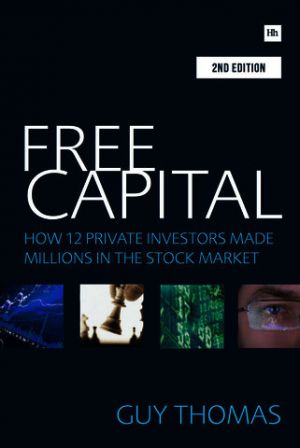
Books that focus on UK investors are relatively rare, so Guy Thomas's Free Capital should be well received.
Indeed, he has comfortably exceeded his goal of writing a 'journalistic profile of the working lives of a few full-time investors' by including regular, well researched and presented sections to explain some of the more esoteric terms and techniques used by the twelve private investors profiled in the book.
Through the window
It's natural for any active private investor to be curious about the lives and techniques of those that have succeeded in a big way, and on that count, this book doesn't disappoint. It describes itself as a window into the world of twelve highly successful private investors who have accumulated £1m or more from investing - in most cases, considerably more with typical compounded returns of around 30% a year.
They remain anonymous apart from the well-known Peter Gyllenhammar who often has notifiable interests in smaller companies, and John Lee, the Liberal Democrat peer, who is known for his investment writings in the Financial Times, and his former activities as a Tory MP and minister. However, a few of the twelve post on our discussion boards, so some of our regulars may well be able to guess their identities.
All twelve have made their investment fortunes in their own unique way. Indeed, there are multiple methods, lifestyles, education levels and personalities featured in the book, which is organised into separate chapters for each investor. At the end of each chapter, a useful summary box that features the insights and advice that can be gleaned from each investor's story is included.
Seeing things the same
However, there are similarities, and despite their many differences, the twelve have the following in common according to the book's conclusion section:
1. A future time perspective
From an early age, these investors were focussed on saving, earning and investing money for the future.
2. No overnight success
Most had a long period of largely lacklustre investing before achieving outstanding results.
3. Using money to facilitate freedom rather than consumption
Most appear to live modest lifestyles relative to their wealth.
4. Low appetite for leverage
The returns have generally not been achieved with the use of excessive leverage such as that available on spread betting accounts.
5. Concentrated portfolios
Most have concentrated portfolios with a small number of shares, or most of their funds in a select few shares, within a larger overall portfolio.
6. Smaller companies
Most invest in smaller companies and rarely hold shares in FTSE 350 companies.
7. Independence
All work largely alone and rarely take advice from others.
Seeing things differently
Individually, the investors provide some useful insights to help illuminate the strategies that have proven to be so successful for them.
For example, Luke, who is described as a top-down investor holding a very concentrated portfolio, advises 'pick the right train' by looking for fields of investment with long-term secular growth. He suggests concentrating on the quality rather than the quantity of decisions and to 'stick with your best ideas', which is precisely what he has done by riding Soco International (LSE: SIA), multiplying his capital 42 times over a ten-year period. That could be why he's 'happy doing nothing' rather than being an active trader.
This advice chimes with Nigel's approach, which is to anticipate cyclical markets using market psychology and fundamentals. He says that 'everyone is a genius in a bull market - so find a bull market!' For Nigel, that means looking for markets in a cyclical upswing; however, he differs from Luke by advising 'sell half when a stock doubles'.
In contrast, Vernon is described as a contrarian who buys growth companies that have stumbled several times. He tries to 'buy the glitch', in other words, to take advantage of profit warnings, demotions from indices and other temporary problems that render the shares unpopular and cheap compared to the value of the underlying business. The trick is to identify those companies with truly temporary setbacks and not those with more enduring problems, so that the investor may ride the recovery.
Other investment styles feature too, like activists who like to mix it with company managements; networkers who love to attend AGMs and badger directors on the phone; esoteric investors with specialist niches and one successful day-trader.
Soap
As well as investment styles, this book provides insight into these investors' daily lives and there is great variety there, as well. I'll let you form your own conclusions on that aspect by reading the book!
Overall, Guy Thomas has provided us with something of a future investment classic in my view, which may help to motivate, ground and focus the reader at the same time; I heartily recommend it. It's also worth visiting Guy's blog for more investing wisdom.